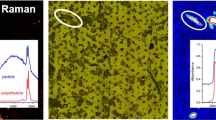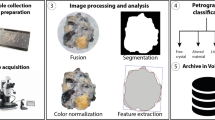Summary
Micro-methods are described for the analysis of rocks and minerals for their major constituents. Silica is determined spectrophotometrically using a 5-mg sample, which is opened up by fusion with sodium hydroxide. An approximately 25-mg sample is decomposed with a mixture of hydrofluoric and perchloric acids and used for the determination of phosphorus and the metallic elements. Highly sensitive spectrophotometric methods are used for the determination of aluminium, total iron, titanium, manganese and phosphorus. Iron is determined as its complex with sulphonated bathophenanthroline, titanium with phenylfluorone, manganese with formaldoxime. Calcium and magnesium are determined chelatometrically using a photoelectric titrimeter, after removal of interfering elements by extraction of their complexes with 8-hydroxy-quinoline. Sodium and potassium are estimated using a flame photometer.
Triplicate analyses of the U. S. Geological Survey standard diabase W 1 and granite G 1 are in good agreement with previously recorded values.
Zusammenfassung
Mikromethoden zur Analyse der Hauptbestandteile von Gesteinen und Mineralen wurden beschrieben. Siliciumdioxyd wird spektrophotometrisch in einer 5-mg-Einwaage bestimmt, die mit Natriumhydroxyd aufgeschlossen wird. Eine 25-mg-Einwaage wird mit einer Mischung von Flußsäure und Perchlorsäure aufgeschlossen und für die Bestimmung des Phosphors und der Metalle verwendet. Hochempfindliche spektrophotometrische Verfahren werden für die Bestimmung von Aluminium, Gesamteisen, Titan, Mangan und Phosphor verwendet. Das Eisen wird mit sulfoniertem Bathophenanthrolin (4,7-Diphenyl-1,10-Phenanthrolin),Titan mit Phenylfluoron, Mangan mit Formaldoxim in Form der entsprechenden Komplexe gemessen. Calcium und Magnesium werden komplexometrisch photoelektrisch titriert, nachdem die störenden Elemente als Oxinate extrahiert wurden. Natrium und Kalium werden flammenphotometrisch bestimmt.
Je drei Parallelanalysen der Standardpräparate des US Geological Survey Diabas W 1 und Granit G 1 führten zu guter Übereinstimmung mit anderwärts mitgeteilten Ergebnissen.
Résumé
Description de microméthodes de dosages des principaux constituants de roches et de minéraux. La silice est dosée par spectrophotométrie sur un échantillon de 5 mg préalablement traité par fusion en présence de soude. Pour la détermination du phosphore et des éléments métalliques on décompose un échantillon d'environ 25 mg par un mélange d'acides fluorhydrique et perchlorique. On utilise des méthodes spectrophotométriques de haute sensibilité pour le dosage de l'aluminium, du fer total, du titane, du manganèse et du phosphore. Le fer, le titane et le manganèse sont dosés sous la forme de leurs complexes respectifs, le premier avec la bathophenanthroline sulfonée le second avec la phénylfluorone et le troisième avec la formaldoxime. Le calcium et le magnésium sont dosés par chélatométrie, à l'aide d'un titrimètre photoélectrique, après élimination des éléments gênants par extraction de leurs complexes avec l'hydroxy-8 quinoléine. Le sodium et le potassium sont estimés par photométrie de flamme.
Des résultats d'analyses effectuées en triple sur des échantillons types de diabase W 1 et de granit G 1 de l'U. S. Geological Survey concordent d'une façon satisfaisante avec les valeurs antérieurement publiées.
Similar content being viewed by others
Literature
J. P. Riley andH. P. Williams, Mikrochim. Acta [Wien]1959, 516.
J. P. Riley andH. P. Williams, Mikrochim. Acta [Wien]1959, 525.
J. P. Riley, Analyt. Chim. Acta19, 413 (1958).
J. B. Mullin andJ. P. Riley, Analyt. Chim. Acta12, 162 (1955).
J. P. Riley, Unpublished work.
J. P. Riley andH. P. Williams, Unpublished work.
C. P. Hildebrand andC. N. Reilly, Analyt. Chemistry29, 258 (1957).
F. Nydahl, Analyt. Chim. Acta3, 144 (1949).
J. Murphy andJ. P. Riley, J. Marine Biol. Assoc. United Kingdom37, 9 (1958).
L. Shapiro andW. W. Brannock, Rapid Analysis of Silicate Rocks. U. S. Geol. Survey Bull. 1036 C (1956).
H. W.Fairbairn, W.G. Schlecht, R. E. Stevens, W. H. Dennen, L. H. Ahrens andF. Chayes, A co-operative investigation of precision and accuracy in Chemical, Spectrochemical and Modal Analysis of Silicate Rocks. U. S. Geol. Survey Bull. 980 (1951).
H. W. Fairbairn andJ. F. Schairer, Amer. Mineralogist37, 744 (1952).
Author information
Authors and Affiliations
Rights and permissions
About this article
Cite this article
Riley, J.P., Williams, H.P. The microanalysis of silicate and carbonate minerals. Mikrochim Acta 47, 804–824 (1959). https://doi.org/10.1007/BF01216746
Received:
Issue Date:
DOI: https://doi.org/10.1007/BF01216746




